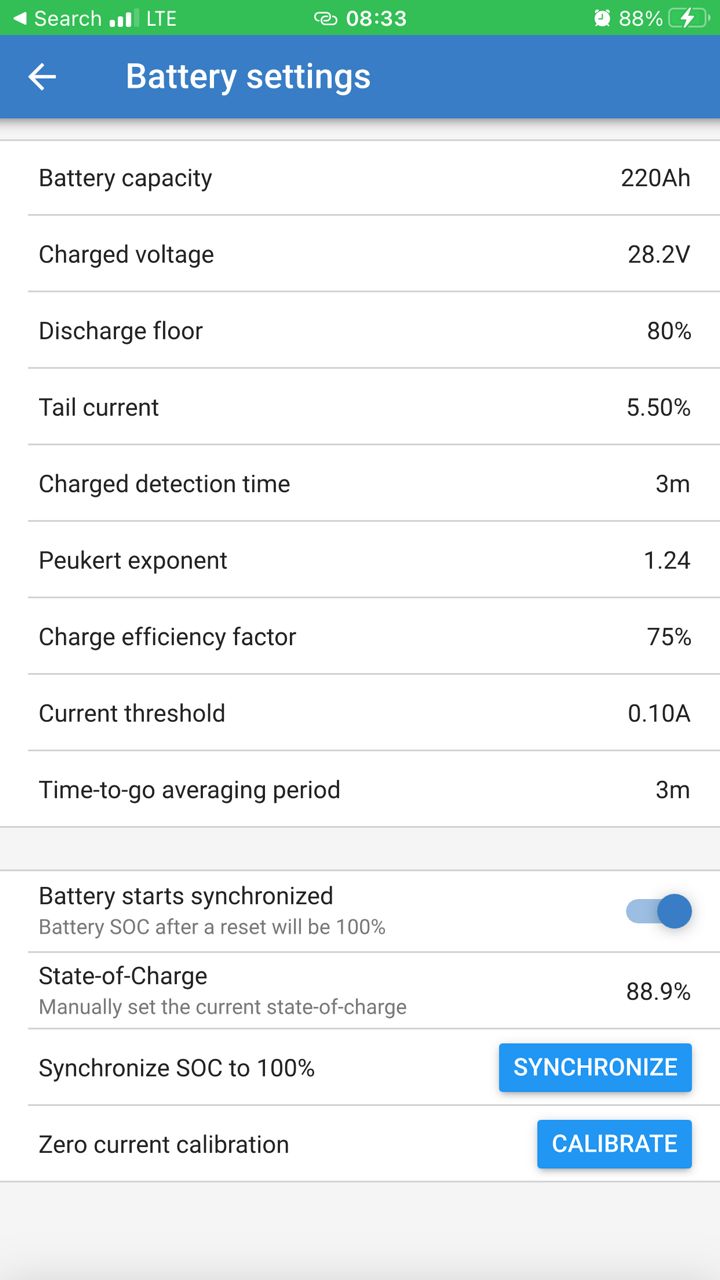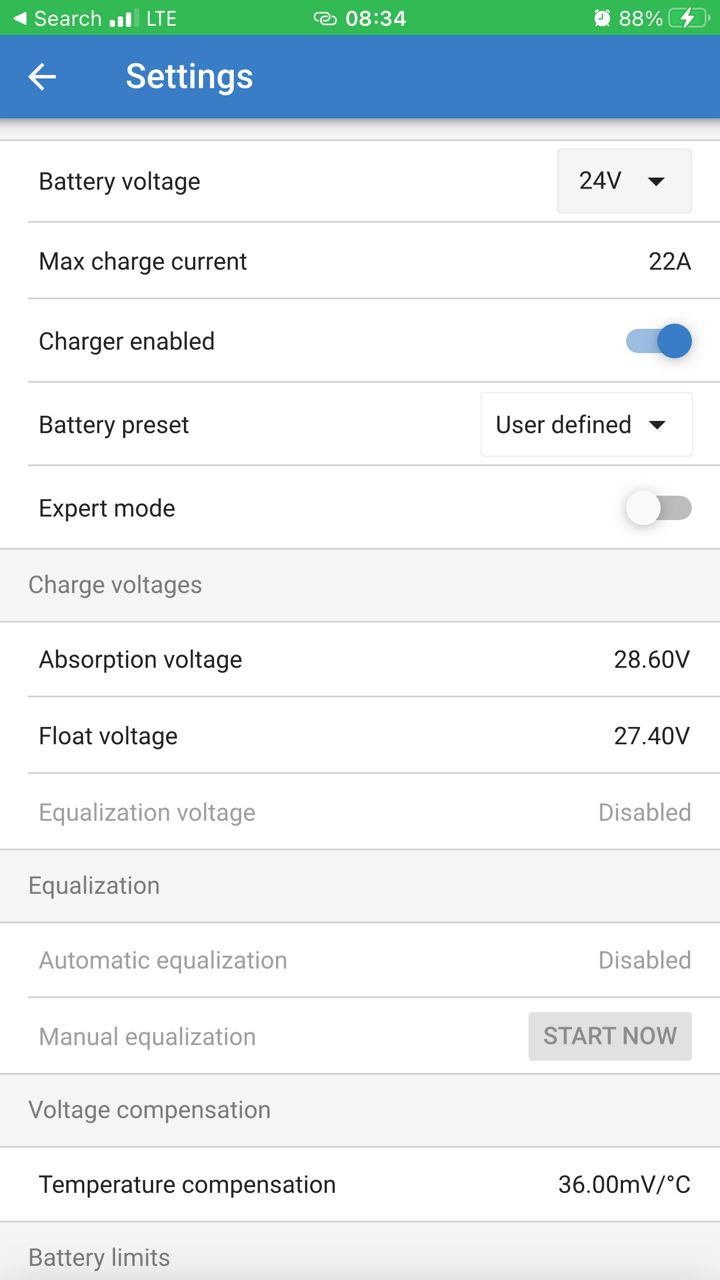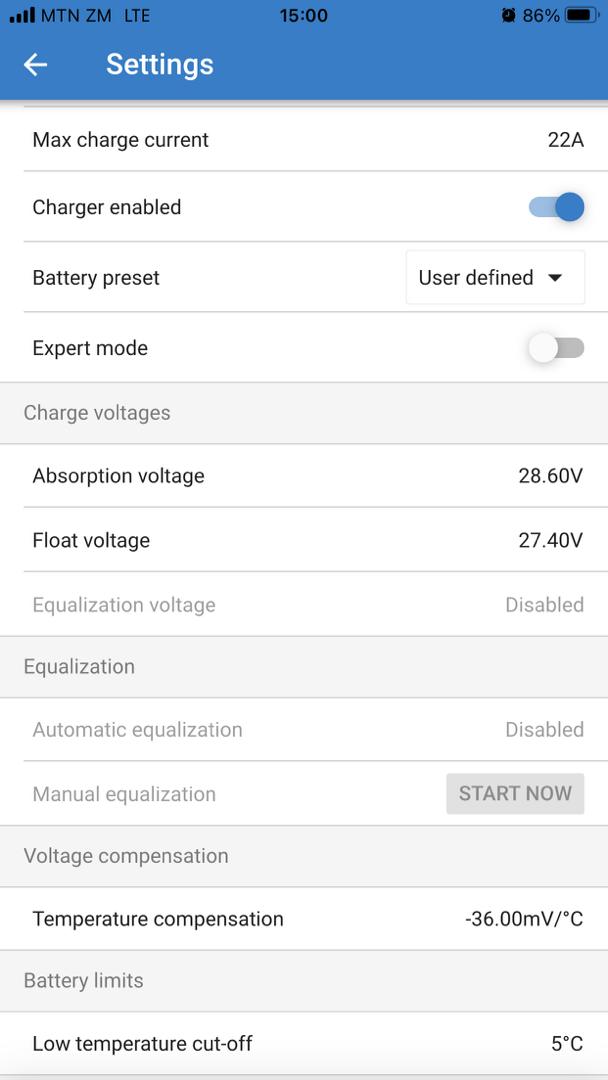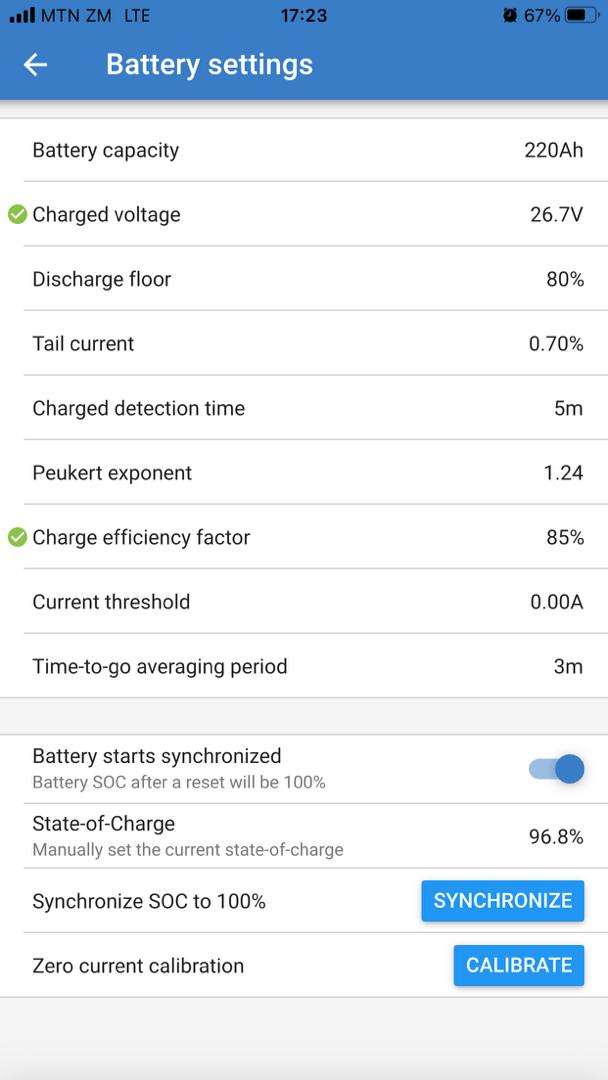I wached Johannes Boonstra's video on setting up a smartshunt with lead acid and lithium batteries. I just installed a Smart Shunt on my offgrid system and followed his recommendation to use the absorption Voltage as the "Charged Voltage". On my MPPT, my float voltage is 27.4V, absorption Voltage 28.6V. I have set my Charged Voltage at 28.2V, Discharge floor at 80% as I only use 15% of of 220AH battery. I have set the Charge efficiency at 75% and charge detection time to 3 minutes and the tail current to 5.5% (12.1A). When my battery was full, I the current reamined at 1.5A, Could my tail current be set too high? Also, the shunt nuver sychronised automatically? Could there be something wrong with my settings? If yes, what should I adjust my settings to?

- Home
- Anonymous
- Sign in
- Create
- Spaces
- Grafana
- Node-Red
- Unsupported topics
- Questions & Answers
- Modifications
- Communauté francophone
- Deutschsprachiger Bereich
- Preguntas en Español
- Explore
- Topics
- Questions
- Ideas
- Articles
- Badges
question
Smart Shunt not automatically synchronising SOC
Sorry if this sounds tough.. but you really should be careful changing these settings until you understand why. Great you're researching and asking though. In this case I see an important one, not so much the Sshunt as the mppt. This is my equivalent at 48V..
 See the *negative* sign? Without it you have Temp Comp working the wrong way, and risk damage to the batts. Easy to miss on a phone, but important.
See the *negative* sign? Without it you have Temp Comp working the wrong way, and risk damage to the batts. Easy to miss on a phone, but important.
On to the shunt. (Excuse the abbreviations).
Your 75% CEF is too low. Your SOC will continually drift downwards and frequent syncs will be essential, not 'as necessary'. Try 90-95%.
You say "When my battery was full, I the current reamined at 1.5A".
And that's a great start. Equal to ~0.7% Tail on your 220Ah of batt, and you'd use a Tail setting higher than this (the closer, the more accurate, but it must be reproducible regularly). But the important thing there is at what V? Absorb or Float? It's likely Float, and if so I'd start with a CV maybe 0.3V lower than your mppt Float setting (this to dodge the Temp Compensated setting in the mppt). Others, especially Li users, may disagree with whether to sync in Abs or Float. And you can choose, but the Tail % must be set appropriately to the V you have at the time you want to sync.
I won't rant on further now. Best to get the fundamentals under control first. You ain't at the fine tuning stage yet, but you'll get there. Come back as you need.
Thanks for that feedback @JohnC.
On the Temp Compensation, I picked that early this morning and added the "-" its -36 as shown in the screenshot below. I hope its not too late and hope the batteries are not yet damaged? This was on for 1 day only.
On the VC, im using the absorption voltage, I have set my VC 0.4 less my absorption voltage. In the video by Johannes Boonstra, this is his suggestion if there is no grid charge on the system and this is to manage the issue of cloud intermittent cloud covers were the votage drops slows and the current drops signifcantly causing the Shunt to sync to 100% SOC. Please see the link for the video below.
Regarding the charge efficiency, I only use 14% of my battery capacity and again in the same video, Johannes Boonstra advised a charge efficiency of between 75-80% for lead acid batteries if they are only cycled in the up range.
https://www.youtube.com/watch?v=mEN15Z_S4kE

I was worried long-term with the -ve thing. Only an issue really with hot batts, and 1 day no problem.
If you've decided to sync in Abs that's ok, as long as you know that sync can't then occur when in Float. To keep this under control you could look at using the Tail function in the mppt, which when networked to the shunt can terminate Abs always at much the same SOC (a great feature in any case). It's listed in Amps rather than %, but if you had sync arranged to happen just before the drop to Float then it would always comply. Depending on your batts this might happen 'fairly' close to 100% SOC anyway, but you'd need to learn to live with that. Ideally the 100% sync would be selectable to something lower, say 98%. Now that would be some feature too.
The false cloud syncs can indeed happen with 'sluggish' batts, and even on-the-way-up, very early in the charge cycle. The Charged Detection Time can be increased a little to prevent this.
Cycling in the upper SOC range will lower overall CEF. There's also a reationship with Peukert, and even Temp, but I still think you'll need to raise CEF into the low 90's. Easily tested, if sync always comes with a large stepup in SOC from the calculated, then it needs raising.
I draw down 15-25% usually, and for comparison these are my summer settings (48V FLA batts)..

Thanks @JohnC. Why is your Puekert Exponent on the higher end? I thould for FLA this should be around 1.25? I have changed my settings based on yours which seem to be working. Lets see if I will get any auto syncs of SOC in the next few days.

My low 1.10 Peukert is an experiment. Been there for a few weeks now and I think it's giving me better results. I ran my C20 and C100 batt specs through Victron's Peukert Calculator (website) and it gave me 1.16, and I ran with that for ages. Victron recommend/default 1.25, but that's too much for me (and you?) when normally running low discharge rates. Makes for an overestimated SOC, and while that's a feelgood result, it may inspire false confidence.
Peukert works on discharge, and in VictronConnect you can change it around to see the effect it has on the SOC discharge curve in real time. Cool feature.
I see you've changed to a Float sync setup, and actually had it happen. That's good, but the fact that it happened at 96.5% isn't really conclusive until you get a full cycle in over a day, from 100% (true, not indicated) start and finish. If you actually have that, then the 3.5% difference can be corrected by raising CEF (and I still think you need to go further there).
The Trends in VictronConnect are great to watch all this, especially that cloud-effect thingy (with V). This I snipped from mine today (no cloud)..

The step in A is the mppt dropping from Abs to Float at 7A, and you can see SOC making it to 100% before the sync, set at 1.35A. Maybe 0.4% too early, and I wonder why when that happens. My clue was the slightly wandering A reading, which I put down to cell bubbles. Sure enough, they needed a topup, which I did, and that stopped. So I'll just wait for tomorrow and check again. Yeh, love my graphs.. :)
I think you're getting close, but be patient and think it out.
Are you now done fine tuning your system?
Good work. Pretty close now.
The Ah I don't look at much. It's not actually a measure of energy until you multiply it by V, then it becomes Wh, and only then useful for calcs. That Victron report Ah at all may be a concession to consumerism.
I don't fiddle with the settings much now, the day-to-day variations I can live with. Summer here now, but in Winter I'd expect to change Tail up 0.1%, CEF up 1%, and Peukert back to 1.16. Short days, deeper batt discharge, and ~20degC colder batts all have an effect.
How obsessed you get is up to you, but some of the Victron apps and possibly functions only deal in integer SOC digits, and I know my SOC reading is better than that.
Have fun though, don't let me spoil it.. :)
question details
26 People are following this question.
